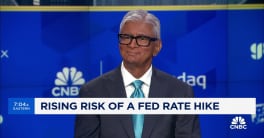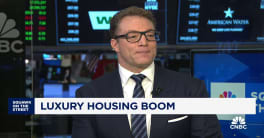Yesterday we called attention to a Caroline Baum column on Bloomberg that suggested housing needs an act of God for home prices to recover quickly. Below is an excerpt from her commentary...
How I Missed the ‘Housing Recovery’ of 2010: Caroline Baum
"The U.S. just experienced the biggest speculative boom/bust in housing in history, a massive outward shift in the supply curve. Anyone expecting home prices to rise in the face of a glut of unsold homes is counting on either an act of God to destroy huge swaths of the housing stock (a shift back in the supply curve) or an influx of new immigrants needing shelter (a shift out in the demand curve.) Neither is likely, although acts of God are notoriously hard to predict."
Whether or not Caroline was suggesting we should just bulldoze excess inventory to balance out supply and demand is unclear, but the notion of a quick cleansing process through destruction of dilapidated inventory raises an interested eyebrow, especially when you consider the damage done to the credit profiles and life savings of potential homebuyers (in combination with tighter UW regs).
This idea seems like "pie in the sky", but somebody is taking it seriously....
WASHINGTON POST: Olmsted's ideals could help solve our real estate mess
By Michael G. Messner
More than 150 years ago, America's greatest landscape architect, Frederick Law Olmsted, created Central Park and changed New York forever. He went on to transform dozens more cities, leaving a priceless legacy of vibrant, beautiful cityscapes. And, in the process, he increased property values.
Olmsted discovered this himself when he tracked the value of land around Central Park and found that the city's $13 million investment had led to an astounding $209 million increase in just 17 years. The architect recognized what many planners still fail to grasp: Parks and managed green space are vital pieces of urban infrastructure that not only improve the quality of life for millions of people but also drive economic growth.
Today we must act again to transform our cities. The commercial real estate binge of the past decade and the growth of online shopping as an alternative to brick-and-mortar stores have left more than 200,000 acres of vacant retail, office and industrial space. Residential real estate is a massive problem as well. Distressed properties are a drag on our communities and the economy and threaten to topple even more banks that hold mortgages on these "toxic assets."
We need to move these toxic assets off the banks' books, reduce the surplus of commercial space and create jobs, all while revitalizing our cities. This brings us back to Olmsted.
Olmsted designed transformative parks, campuses and greenways; his firm completed an amazing 6,000 commissions and launched a green wave across 19th-century America. The same kind of wave could help resolve the 21st-century real estate mess.
We don't have the luxury of vacant land that Olmsted often started with, so we must bulldoze underperforming and underused property, put people to work creating parks on some of the land and "bank" the rest until the economy recovers.
Beginning with Atlanta, Georgia Tech is researching what is needed to accomplish this in 12 major cities. The project is known as Red Fields to Green Fields. Under this plan, some of the abandoned or underutilized property would be acquired by a parks agency or by public-private partnerships, which would then begin demolition, park design and construction, putting people to work immediately. More jobs would come as the improved areas attracted development.
This would not be the first time that property has been bulldozed for economic gain. The railroads, which had many miles of underused track to maintain, pulled up 55 percent of their tracks in the past 60 years to increase profitability, enabling the creation of 19,000 linear miles of "rails-to-trails" parks. Pittsburgh, realizing that the steel industry was never coming back, tore down riverfront steel mills and replaced them with an attractive mix of parks and office space. In Michigan, Flint and Detroit are finding ways to "bank" land as open space.
The banking system and the federal government could play an important role in this effort. Rather than backstop bad real estate paper, the Federal Reserve, the Federal Deposit Insurance Corp. and the Treasury Department could help finance the acquisition of excess commercial real estate through a land bank fund. Instead of buying mortgage-backed securities, why couldn't the Fed buy excess developed real estate to be held as green space through "land-backed securities"? Why couldn't the FDIC give some of the useless properties it obtains through bank closures to land banks or nonprofit organizations? With the right financing structure, philanthropic entrepreneurs could use leverage to remake America just as some of our bad developers used easy bank financing to help create the excesses.
Acquisition money could also come from expanding tax incentives that encourage banks and landlords to donate land and encourage wealthy individuals and corporations to buy conservation tax credits. Georgia Tech's analysis has also shown that the money needed for a nationwide program would be a tiny fraction of current real estate support programs, such as the Fed's "quantitative easing" or its recent purchase of $1.5 trillion in mortgages.
The 2009 stimulus package did much to protect jobs but little to stimulate the economy with transformational investments.
Converting underused commercial real estate to green space and "banked" land would be transformational. It would create jobs, strengthen the banking system to encourage lending and stabilize property values so that real estate owners would be ready to spend again. Most important, lush new parks would enhance neighborhoods across the country.
Michael G. Messner is a Wall Street investment fund manager. He and his wife, Jenny, funded the documentary "The Olmsted Legacy," which will air on WHUT-Channel 32 Saturday at 10 p.m., and are funding the Red Fields to Green Fields research at Georgia Tech.
-----------------------------------------------------------
I'm not advocating this idea as a broad based solution but it could be a starting point in the hardest hit areas. Not only does it remove excess inventory, it creates jobs, improves quality of life and incentivizes homeowners who haven't missed a payment to stay current and resist the temptation of strategic default. We don't need 6 or 7 more Detroits.
When you're stuck in a hole, you don't keep digging to get yourself out...







